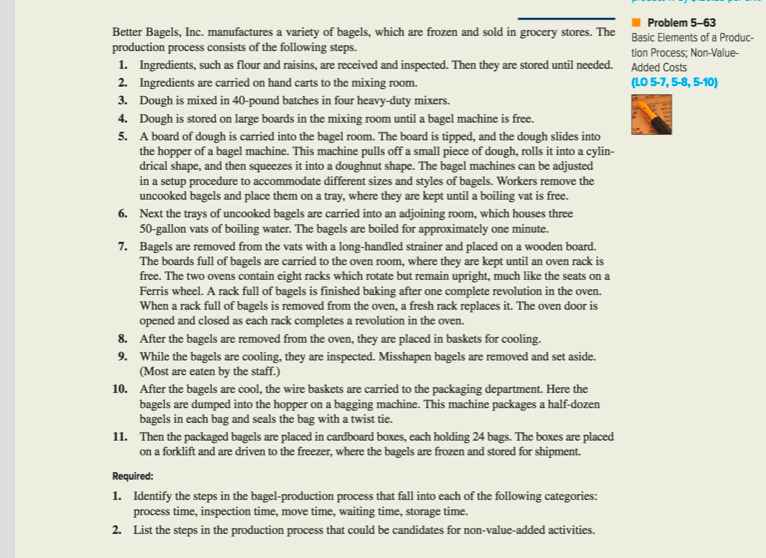Better Bagels, Inc. manufactures a variety of bagels, which are frozen and sold in grocery stores. The production process consists of the following steps. 1. Ingredients, such as flour and raisins, are received and inspected. Then they are stored until needed. 2. Ingredients are carried on hand carts to the mixing room. 3. Dough is mixed in 40-pound batches in four heavy-duty mixers. 4. Dough is stored on large boards in the mixing room until a bagel machine is free. 5. A board of dough is carried into the bagel room. The board is tipped, and the dough slides into the hopper of a bagel machine. This machine pulls off a small piece of dough, rolls it into a cylin- drical shape, and then squeezes it into a doughnut shape. The bagel machines can be adjusted in a setup procedure to accommodate different sizes and styles of bagels. Workers remove the uncooked bagels and place them on a tray, where they are kept until a boiling vat is free. 6. Next the trays of uncooked bagels are carried into an adjoining room, which houses three 50-gallon vats of boiling water. The bagels are boiled for approximately one minute. 7. Bagels are removed from the vats with a long-handled strainer and placed on a wooden board. The boards full of bagels are carried to the oven room, where they are kept until an oven rack is free. The two ovens contain eight racks which rotate but remain upright, much like the seats on a Ferris wheel. A rack full of bagels is finished baking after one complete revolution in the oven. When a rack full of bagels is removed from the oven, a fresh rack replaces it. The oven door is opened and closed as each rack completes a revolution in the oven. 8. After the bagels are removed from the oven, they are placed in baskets for cooling. 9. While the bagels are cooling, they are inspected. Misshapen bagels are removed and set aside. (Most are eaten by the staff.) 10. After the bagels are cool, the wire baskets are carried to the packaging department. Here the bagels are dumped into the hopper on a bagging machine. This machine packages a half-dozen bagels in cach bag and seals the bag with a twist tie. 11. Then the packaged bagels are placed in cardboard boxes, each holding 24 bags. The boxes are placed on a forklift and are driven to the freezer, where the bagels are frozen and stored for shipment. Required: 1. Identify the steps in the bagel-production process that fall into each of the following categories: process time, inspection time, move time, waiting time, storage time. 2. List the steps in the production process that could be candidates for non-value-added activities.
Better Bagels, Inc. manufactures a variety of bagels, which are frozen and sold in grocery stores. The production process consists of the following steps. 1. Ingredients, such as flour and raisins, are received and inspected. Then they are stored until needed. 2. Ingredients are carried on hand carts to the mixing room. 3. Dough is mixed in 40-pound batches in four heavy-duty mixers. 4. Dough is stored on large boards in the mixing room until a bagel machine is free. 5. A board of dough is carried into the bagel room. The board is tipped, and the dough slides into the hopper of a bagel machine. This machine pulls off a small piece of dough, rolls it into a cylin- drical shape, and then squeezes it into a doughnut shape. The bagel machines can be adjusted in a setup procedure to accommodate different sizes and styles of bagels. Workers remove the uncooked bagels and place them on a tray, where they are kept until a boiling vat is free. 6. Next the trays of uncooked bagels are carried into an adjoining room, which houses three 50-gallon vats of boiling water. The bagels are boiled for approximately one minute. 7. Bagels are removed from the vats with a long-handled strainer and placed on a wooden board. The boards full of bagels are carried to the oven room, where they are kept until an oven rack is free. The two ovens contain eight racks which rotate but remain upright, much like the seats on a Ferris wheel. A rack full of bagels is finished baking after one complete revolution in the oven. When a rack full of bagels is removed from the oven, a fresh rack replaces it. The oven door is opened and closed as each rack completes a revolution in the oven. 8. After the bagels are removed from the oven, they are placed in baskets for cooling. 9. While the bagels are cooling, they are inspected. Misshapen bagels are removed and set aside. (Most are eaten by the staff.) 10. After the bagels are cool, the wire baskets are carried to the packaging department. Here the bagels are dumped into the hopper on a bagging machine. This machine packages a half-dozen bagels in cach bag and seals the bag with a twist tie. 11. Then the packaged bagels are placed in cardboard boxes, each holding 24 bags. The boxes are placed on a forklift and are driven to the freezer, where the bagels are frozen and stored for shipment. Required: 1. Identify the steps in the bagel-production process that fall into each of the following categories: process time, inspection time, move time, waiting time, storage time. 2. List the steps in the production process that could be candidates for non-value-added activities.
Survey of Accounting (Accounting I)
8th Edition
ISBN:9781305961883
Author:Carl Warren
Publisher:Carl Warren
Chapter10: Accounting Systems For Manufacturing Operations
Section: Chapter Questions
Problem 10.6C: Just-in-time principles Warm Space Inc. manufactures electric space heaters. While the CEO, Gwen...
Related questions
Question
100%
please help me with his question

Transcribed Image Text:Problem 5-63
Better Bagels, Inc. manufactures a variety of bagels, which are frozen and sold in grocery stores. The Basic Elements of a Produc-
production process consists of the following steps.
tion Process; Non-Value-
1. Ingredients, such as flour and raisins, are received and inspected. Then they are stored until needed. Added Costs
(LO 5-7, 5-8, 5-10)
2. Ingredients are carried on hand carts to the mixing room.
3. Dough is mixed in 40-pound batches in four heavy-duty mixers.
4. Dough is stored on large boards in the mixing room until a bagel machine is free.
5. A board of dough is carried into the bagel room. The board is tipped, and the dough slides into
the hopper of a bagel machine. This machine pulls off a small piece of dough, rolls it into a cylin-
drical shape, and then squeezes it into a doughnut shape. The bagel machines can be adjusted
in a setup procedure to accommodate different sizes and styles of bagels. Workers remove the
uncooked bagels and place them on a tray, where they are kept until a boiling vat is free.
6. Next the trays of uncooked bagels are carried into an adjoining room, which houses three
50-gallon vats of boiling water. The bagels are boiled for approximately one minute.
7. Bagels are removed from the vats with a long-handled strainer and placed on a wooden board.
The boards full of bagels are carried to the oven room, where they are kept until an oven rack is
free. The two ovens contain eight racks which rotate but remain upright, much like the seats on a
Ferris wheel. A rack full of bagels is finished baking after one complete revolution in the oven.
When a rack full of bagels is removed from the oven, a fresh rack replaces it. The oven door is
opened and closed as each rack completes a revolution in the oven.
8. After the bagels are removed from the oven, they are placed in baskets for cooling.
9. While the bagels are cooling, they are inspected. Misshapen bagels are removed and set aside.
(Most are eaten by the staff.)
10. After the bagels are cool, the wire baskets are carried to the packaging department. Here the
bagels are dumped into the hopper on a bagging machine. This machine packages a half-dozen
bagels in each bag and seals the bag with a twist tie.
11. Then the packaged bagels are placed in cardboard boxes, each holding 24 bags. The boxes are placed
on a forklift and are driven to the freezer, where the bagels are frozen and stored for shipment.
Required:
1. Identify the steps in the bagel-production process that fall into each of the following categories:
process time, inspection time, move time, waiting time, storage time.
2. List the steps in the production process that could be candidates for non-value-added activities.
Expert Solution
This question has been solved!
Explore an expertly crafted, step-by-step solution for a thorough understanding of key concepts.
This is a popular solution!
Trending now
This is a popular solution!
Step by step
Solved in 2 steps with 1 images

Knowledge Booster
Learn more about
Need a deep-dive on the concept behind this application? Look no further. Learn more about this topic, accounting and related others by exploring similar questions and additional content below.Recommended textbooks for you

Survey of Accounting (Accounting I)
Accounting
ISBN:
9781305961883
Author:
Carl Warren
Publisher:
Cengage Learning

Financial & Managerial Accounting
Accounting
ISBN:
9781285866307
Author:
Carl Warren, James M. Reeve, Jonathan Duchac
Publisher:
Cengage Learning

Financial & Managerial Accounting
Accounting
ISBN:
9781337119207
Author:
Carl Warren, James M. Reeve, Jonathan Duchac
Publisher:
Cengage Learning

Survey of Accounting (Accounting I)
Accounting
ISBN:
9781305961883
Author:
Carl Warren
Publisher:
Cengage Learning

Financial & Managerial Accounting
Accounting
ISBN:
9781285866307
Author:
Carl Warren, James M. Reeve, Jonathan Duchac
Publisher:
Cengage Learning

Financial & Managerial Accounting
Accounting
ISBN:
9781337119207
Author:
Carl Warren, James M. Reeve, Jonathan Duchac
Publisher:
Cengage Learning

Corporate Financial Accounting
Accounting
ISBN:
9781337398169
Author:
Carl Warren, Jeff Jones
Publisher:
Cengage Learning

Accounting (Text Only)
Accounting
ISBN:
9781285743615
Author:
Carl Warren, James M. Reeve, Jonathan Duchac
Publisher:
Cengage Learning

Accounting
Accounting
ISBN:
9781337272094
Author:
WARREN, Carl S., Reeve, James M., Duchac, Jonathan E.
Publisher:
Cengage Learning,